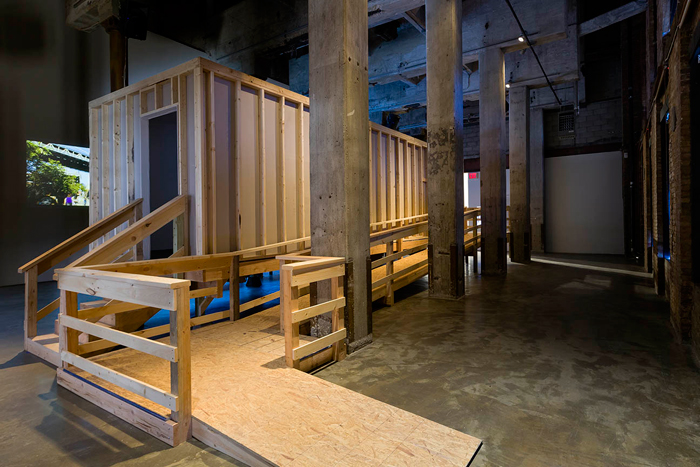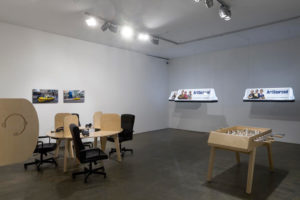Smack Mellon is pleased to present Erica Bailey’s multimedia installation Its memory, the memory of its ribs, its knees, its shoulders, and Yumi Janairo Roth and Nadine Wasserman’s collaborative project ArtSourced: Call Center.
Detailed 1/12 scaled dioramas housed within Erica Bailey’s three-room installation allow viewers to experience intimate rooms from the artist’s past. Fragments of her adolescent bedroom in rural Ohio and her recently vacated Harlem studio apartment are presented as emptied, transient spaces alongside a disorienting view of Smack Mellon’s imposing interior architecture. Large video projections outside the elevated structure shift the scale once again in this uncanny architectural collage.
Inspired by global call centers, Yumi Janairo Roth and Nadine Wasserman transform the back gallery to functions as exhibition, performance, social sculpture and active call center for artists. On March 14, viewers are invited to call into a Philippines-based call center, manned by Filipino artists working with 98B COLLABoratory, for customer/technical support with artistic difficulties. In contrast to the typical call center experience with an anonymous disembodied voice, ArtSourced: Call Center subtly explores the dynamic between client and agent, questioning an accustomed relationship often filled with unspoken cultural assumptions.
Erica Bailey
Its memory, the memory of its ribs, its knees, its shoulders
By choosing to represent spaces relative to my personal experience this project marks a more explicitly personal exploration of built space and its social and psychological underpinnings than my past projects. I have selected two intimate spaces of dwelling—one of adolescence, my bedroom in the house in which I grew up in Shiloh, Ohio, a space of memory and of distance, remote both in terms of time and space, and the other, the studio apartment in Harlem in which I lived upon first moving to New York in January of 2012, a space I only recently left. These lived-in, slept-in, dreamt-in, and awakened-in spaces are contrasted with a representation of the Smack Mellon gallery space, a public space, only casually known to me, but significant as the place of presentation in which the two private spaces are given to the public.
All of the spaces are represented empty—suggesting a time before or after the living, sleeping, dreaming, awaking, or presenting occurs. This sense of transience is heightened by the continual shifting of location that plays out in the video, and along with the peculiar orientation of each of the dioramas, it acts to subverts spatial expectations. Each location—Harlem, Shiloh, and DUMBO—only intermittently accompanies its pertinent interior. The 1/12 scale of the dioramas, a common dollhouse scale, allows for the disparate spaces to be experienced in a proximity not otherwise possible, revealing how the Smack Mellon exhibition space, originally a boiler house supplying heat and power to nearby properties, dwarfs the two domestic interiors.
The structure itself is at once a contrivance for lifting the floor (thereby making possible the recessing of the dioramas) and an ode to both the concept of “room” and to the act of “building”. With its framing exposed, it exists as naked evidence of its own construction. Meanwhile, its skeletal appearance is suggestive of the body evoked in the quote from which I have taken the title of the piece. In the quote, from Lydia Davis’s translation of Proust’s In Search of Lost Time, it is the body that is engaged in the act of remembering a space: “Its memory, the memory of its ribs, its knees, its shoulders, offered in succession several of the rooms where it had slept, while around it the invisible walls, changing place according to the shape of the imagined room, spun through the shadows.” The three rooms of the structure, yet to take full form, are suspended in the indeterminate zone that is both a room and a black space. Like a conventional gallery space in that respect, each serves as an intimate gallery for the diorama it contains.
Erica Bailey is a New York-based multimedia artist whose work explores themes of alienation, disorientation, indeterminacy, anxiety, and senselessness through built environments of varying scale. Originally from Ohio, she holds a BFA in sculpture from The Ohio State University and an MFA in three-dimensional media from the University of Cincinnati. She has created several large-scale installations, including The House that was Haunted Before It was Built (2007), a small, two-story house built in the Aronoff Center for Art and Design at the University of Cincinnati and Telescoping House (2010), her second free-standing house project, for the UnMuseum of the Cincinnati Contemporary Arts Center. She was recently a resident artist at the NARS Foundation in Brooklyn. Its memory, the memory of its ribs, its knees, its shoulders marks Bailey’s first solo exhibition in New York.
Yumi Janairo Roth and Nadine Wasserman
ArtSourced: Call Center
ArtSourced: Call Center is a collaborative art project that will function as an exhibition and performance space where creative blocks and artistic difficulties are explored and resolved. Working with 98B COLLABoratory in Manila, the Philippines, ArtSourced: Call Center will explore collaboration as cross-cultural practice between US and Filipino artists. In the global economy, outsourcing often takes the form of call centers that provide customer/technical support, marketing/outreach services to clients normally based in developed countries. However, despite the pervasiveness of call centers and our reliance on their diverse services, very little in contemporary art has explored the dynamic between client and agent, a relationship often fraught with many unspoken cultural assumptions pertaining to legitimacy, education, and creativity.
Yumi Janairo Roth was born in Eugene, OR and raised in Chicago and suburban Washington DC. She currently lives and works in Boulder, Colorado where she is a professor of sculpture at the University of Colorado. Yumi has created a diverse body of work that explores ideas of immigration, hybridity, and displacement through discrete objects and site-responsive installations, solo projects as well as collaborations. In her projects, her objects function as both natives and interlopers to their environments, simultaneously recognizable and unfamiliar to their users. She received a BA in anthropology from Tufts University, a BFA from the School for the Museum of Fine Arts-Boston and an MFA from the State University of New York- New Paltz. She has exhibited and participated in artist-in-residencies nationally and internationally, including New York (Bronx River Art Center, Sara Meltzer Gallery, Momenta Art, Lower Manhattan Cultural Council, Smack Mellon, Cuchifritos), San Francisco (Limn Gallery), Portland (Institute of Contemporary Art, Map Room) Houston (Lawndale Art Center, Diverse Works), Boston (New Art Center), Denver/Aspen (Rule Gallery, Center for Visual Arts, Museum of Contemporary Art, Aspen Art Museum), Minneapolis (Soap Factory), Milwaukee (Instituteof Visual Arts, Kohler Arts/Industry), Santa Fe (Museum of Fine Arts), Seattle (Consolidated Works), Mexico (Arcaute Arte Contemporaneo, La Galleria RufinoTamayo), the Philippines (Ayala and Vargas Museums), Colombia (Universidad Nacional de Colombia) Czech Republic (Galerie Klatovy-Klenova, Institute of Art and Design-Pilsen), and Germany (Frankfurter Kunstverein).
Nadine Wasserman is an independent curator and freelance art critic. She has organized many exhibitions and worked with both emerging and established artists. Wasserman has organized both solo and group exhibitions on a diversity of themes and has written about art for multiple publications. In her exhibitions and writing she has explored themes ranging from violence to mundanity. Recent exhibitions include ‘Lifeloggers: Chronicling the Everyday’ and the public art component of the upcoming Three Rivers Arts Festival in Pittsburgh. At the 2013 College Art Association Conference, she presented ‘Filipiniana: Visual, Temporal, and Virtual Voyages across the Pacific (and between the Philippine and South China Sea).’ Wasserman is the recipient of the 2012 Golden Quill Award from The Press Club of Western Pennsylvania for the category of Arts & Entertainment; Article, Series, or Criticism in a Non-Daily Newspaper.
This exhibition is supported, in part, by public funds from the New York City Department of Cultural Affairs, in partnership with the City Council, New York City Council Member Stephen Levin, and the New York State Council on the Arts with the support of Governor Andrew Cuomo and the New York State Legislature, and with generous support from The Andy Warhol Foundation for the Visual Arts, Lambent Foundation, Gilbert Mackay Foundation, Select Equity Group Foundation, many individuals and Smack Mellon’s Members. Yumi Janairo Roth and Nadine Wasserman’s exhibition received additional support from the Puffin Foundation.
Smack Mellon’s programs are also made possible with public funds from the National Endowment for the Arts and with generous support from The Edward and Sally Van Lier Fund of The New York Community Trust, The Roy and Niuta Titus Foundation, Jerome Foundation, Lily Auchincloss Foundation, Inc., Richard J. Massey Foundation for the Arts & Sciences, The Robert Lehman Foundation, The Greenwich Collection Ltd, Milton and Sally Avery Arts Foundation Inc., The O’Grady Foundation, and Exploring The Arts.
Space for Smack Mellon’s programs is generously provided by the Walentas family and Two Trees Management.

